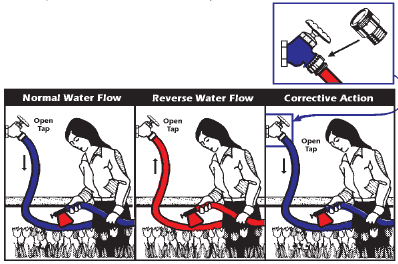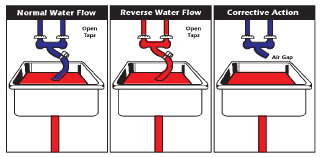 |
 |
|
|
Cross ConnectionsOGRUD works hard to insure that the water we bring to your home is the safest, purest available. That is why we are constantly on the alert for any situation that would degrade that purity. Our cross-connection prevention program is one way that our staff insurse that the water you and your family drink is always the best. We believe, however, that every water customer should know about cross-connections. A cross-connection is any pipe, valve, fixture, etc. in a drinking water plumbing sysstem that may allow the drinking water withing the system to become contaminated or questionable in quality. Even a lawn sprinkler system can be a potential source for contamination. Cross-connections can be eliminated or protected by an air gap or mechanical backflow prevention. Please contact our office for additional information. Clean, safe drinking water. It is something we take for granted, but every home may have potential hazards which threaten to contaminate our drinking water. Ensuring our water is safe is everyone’s responsibility. THE PROBLEMCross Connections - What is a cross connection? A cross connection is a direct link between a household water line and a contaminated source such as a garden hose, toilet tank or laundry tub. The most common contaminants, such as pesticides, sewage and detergents, can enter your drinking water system through cross connections in home water lines. Back Siphonage —Most household cross connections are created by hoses. Under certain conditions, the flow in household water lines can reverse and siphon contaminants into the water supply. For example, using a garden hose to spray pesticides or fertilizers is normally harmless, but if the city’s water supply is interrupted while you are spraying, you may have a problem. If watermain pressure is reduced due to a watermain break or nearby fire fighting, a back siphonage effect is created. This can draw water from your garden hose into your home water supply. So if you have pesticide or fertilizer sprayer attached to your garden hose, the chemicals can contaminate your water supply. Back pressure —Your drinking water can also be contaminated by an effect called back pressure. Back pressure results when your water supply is connected to a system under high pressure such THE SOLUTIONSYou can easily prevent back siphonage by installing inexpensive safety devices or taking a few simple precautions. Solution 1 - Anti-siphon Ballcocks - For example, toilet tanks contain a ballcock device which allows water into the tank after flushing. Older style ballcocks do not have an anti-siphon feature and can allow water from the toilet tank to backflow into your drinking water line. (fig. 1) A simple anti-siphon ballcock (fig. 2) installed with a 25mm (1”) air gap above the overflow tube will prevent contaminated tank water from entering your water supply.
Solution 2 - Hose Connection Vacuum Breakers - You can also prevent back siphonage by using an inexpensive, easy-to-install hose connection vacuum breaker. This one-way valve allows water to flow from the tap, but not back in. (Drainable vacuum breakers should be installed on all taps which could freeze.)  Solution 3 - Air Gaps - Leave a gap of at least one inch or two times the pipe diameter (whichever is greater) between the end of a hose and a source of contamination. This eliminates a link between the two. Never leave a hose where it can suck contaminants back into the drinking water supply, such as in a swimming pool, bathtub, sink or fish tank.  WHEN TO CALL THE EXPERTSHot water boilers for heating homes, underground lawn sprinkler systems, and automobile pressure washers form cross connections which need proper control. Due to the complexity of these systems, a qualified plumber who is a certified Cross Connection Control specialist should be called for advice and assistance. Safe Drinking Water is Everybody's Responsibility Federal and provincial governments are responsible for setting high standards for water quality. Old Gainesboro Road Utility District is responsible for producing and supplying drinking water which meets or exceeds these standards. Homeowners are responsible for ensuring that drinking water does not become contaminated as a result of a cross connection. Remember, you are not only protecting your own water supply, but your neighbors’ as well. Swimming Pools All of the above can be extremely hazardous. For more information, contact our office |

